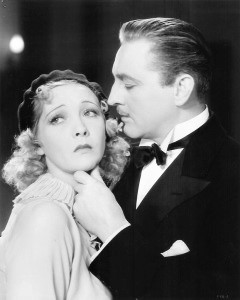
An RKO Production~Director: George Archainbaud, Screenplay by Gene Fowler and Rowland Brown, based on a short story by Louis Stevens, Art Director: Caroll Clark
This film has two great things going for it: a tight script infused with Gene Fowler’s personal knowledge of its semi-fictionalized subject and a pitch-perfect performance by John Barrymore. Both lend dynamic pacing to a movie that fits neatly into a then emerging pre-Code genre, the lawyer picture. This genre seems to have found its initial flowering in 1932 when no less than three, and I would argue more, movies arrived on the scene loosely based upon then-famed criminal defense attorney, William J. Fallon, who defended the famous and infamous. With the 1931 publication of Fowler’s popular biography of Fallon acting as starting shot, the lawyer-based courtroom drama was off and running.
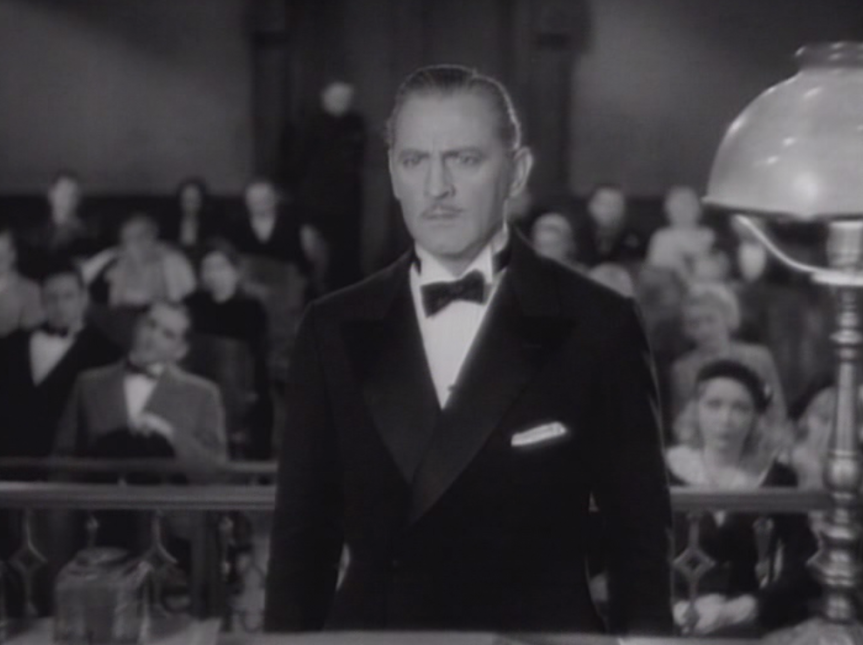
In the opening scene a tipsy defense attorney Tom Cardigan (John Barrymore) accepts 5Gs to defend a renter, a lovely lady accused of tapping on a window to procure ‘clients’, in order to protect the reputation of her landlord Vanny Powers. As apparently this technique was standard procedure for ladies of the evening, Cardigan has no difficulty understanding what is required. And so he delivers, establishing his courtroom finesse and way with women and juries, the judge being female, manipulating one and then the other with essentially fabricated nonsense.
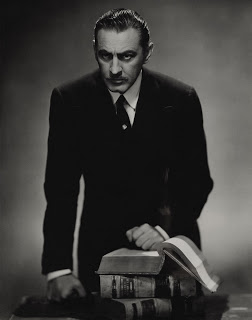
Seeing Barrymore as a lawyer is akin to watching an arm slip into a sleeve. His penchant for delivering snappy dialogue and his engaging manner render him entirely believable. His theatrical nature gave him a fondness for make-up, eye make-up in particular, quite evident in the very first scene, a holdover from his silent days. While this doesn’t bother me, in fact I would prefer to see more men in eye make-up, it does remind us that we are watching The Great Profile at work. This is either good or bad depending upon how you feel about his theatrical style.
Cardigan defends the tapping young woman and things being what they are she accompanies him back to his private apartment. The chemistry between these two establishes their relationship pretty quickly. There’s only a minute or two before he is slowly removing her jacket and seductively kissing her, to which she responds “you have a nice mouth”. One gets the sense that Cardigan has done this before. Yet it’s a nice set up scene and establishes the dynamic between these two; it’s different this time. Pretty June Perry (Helen Twelvetrees) is not only lovely but warm and good-hearted, as many women of the night are apt to be in pre-Code films, and soon is Cardigan’s paramour. Twelvetrees is able to convey emotional depth and is truly moving in many of her scenes.
Powers is soon shot leading to a hospital bedside suggestion that Cardigan could be more help to his pal on the other side of the law, in the prosecutor’s office as opposed to handy DA. Cardigan makes it clear to the thug, “If I go on the other side, I’ll stay there”. There are soon hints that this proposed prosecutors position also holds the possibility of an eventual governorship. Unfortunately for June, the governor has a daughter.
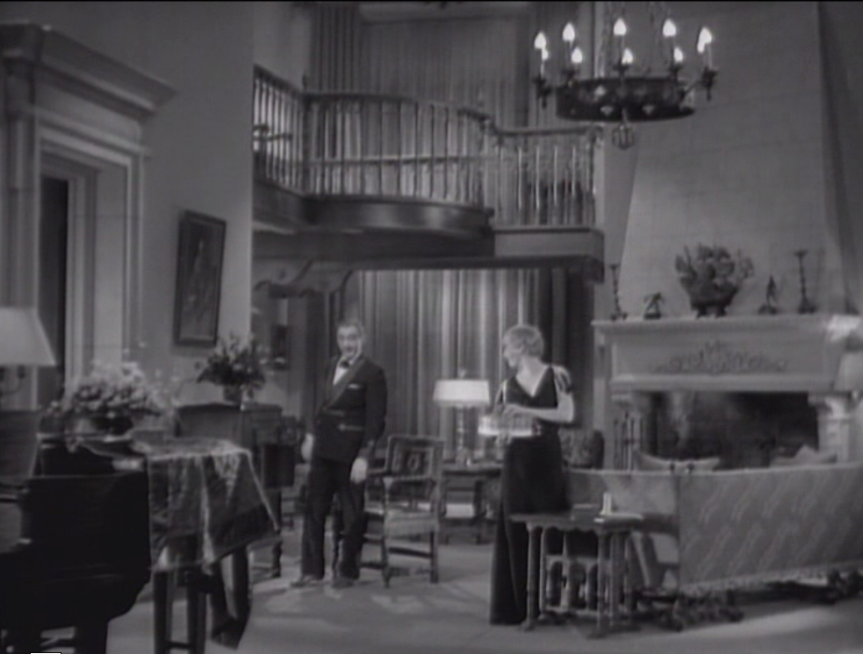
At this point June’s deep love and affection for Cardigan has been well-established. During their time together he is loyal and comes home faithfully to her. He is sweet and adoring. They understand one another. Despite his cynicism we understand that there is a bond between these two and a gentle playfulness. He provides nicely for her despite a lack of vows and she adapts to a more comfortable lifestyle. Her gowns are stylish yet soft and feminine. But he is an ambitious man and when the governor’s daughter, Lillian Ulrich (Jill Esmond) begins to make an overt play for him, it’s not surprising that he begins to stray, particularly given his love for the bottle and someone to share it with.
Throughout this film, Cardigan is essentially portrayed as a man who has been led by events. While ambitious, his career path has been determined by his checkered past and reform school history with Powers. He falls easily into a relationship with an easy woman and just as easily into one with an assertive one.

Lillian in her very first scene is depicted as a ‘modern’ woman and a dangerous one at that. She’s attired in a jacket, white collared shirt and tie and wearing a brimmed hat (an outfit echoed years later in the early balcony scenes of Annie Hall where a very similar costume conveys a very different message). She finds Cardigan’s ties to the underworld exciting and appears to be drawn to him merely for her own entertainment, finding him “thrilling”. In their introductory meeting we learn Cardigan will be prosecuting a woman for the murder of her husband. Interestingly Lillian has little sympathy for the defendant but finds the case titillating while June is repelled by the thought that Cardigan may send a woman to the gallows.
Barrymore opens this second courtroom scene by holding a steady gaze upon the defendant, Nora Dean (Mary Duncan), who accuses him of staring at her legs. As he replies quite plainly “I’m not staring at your legs Madam, I’m looking at your soul”, Lillian pulls her dress down. Apparently she’s not so certain that she would like him to see her own soul.
While the script is truly a good one, it is Barrymore’s masterful working of this fairly lengthy courtroom scene that gives it it’s power. He handles the blunt weight and apparent murder weapon, in such a way as to force a confession from the defendant, tapping not only upon the rail of the jury box but on the metal frame of the very bed where she slept, gave birth, made love and eventually murdered her husband. The tension continually builds as he literally has her, the jury and the audience squirming in their seats. As this high-profile case begins to pave his way to the governorship June expresses her concern that Cardigan is losing his moral bearings. This is an interesting twist as despite his being on the right side of the law , she sees through to the darkening of his soul. Once he expresses that if acting as defense he could’ve gotten the defendant off in a hot minute, June begins to lose respect for him, leaving this weak man vulnerable to finding admiration elsewhere.
(Spoilers Ahead)
Of course things get messy with the governor’s daughter as well as with the extremely shady Powers. When Cardigan won’t play by Powers rules and lay off on charges against his right hand man, he threatens to expose their shared past in reform school, potentially derailing the path to the governorship. There’s a hasty, regretted marriage and the loss of a true love. An obviously drunken Cardigan impulsively marries Lillian, sobers up and regrets it knowing that he’s lost a woman of true worth for one who was merely momentarily exciting. Right and wrong again change places as the better woman is the street walker, the socialite a cold-hearted, empty beauty. A dissent into further alcohol abuse leads to a seedy road and political gain but at a cost to our hero’s soul. The man is torn.

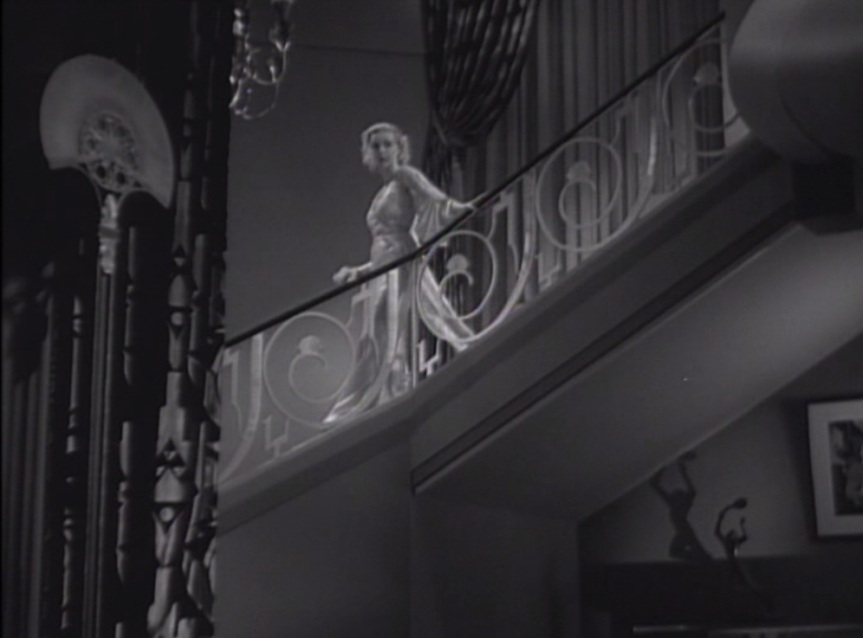
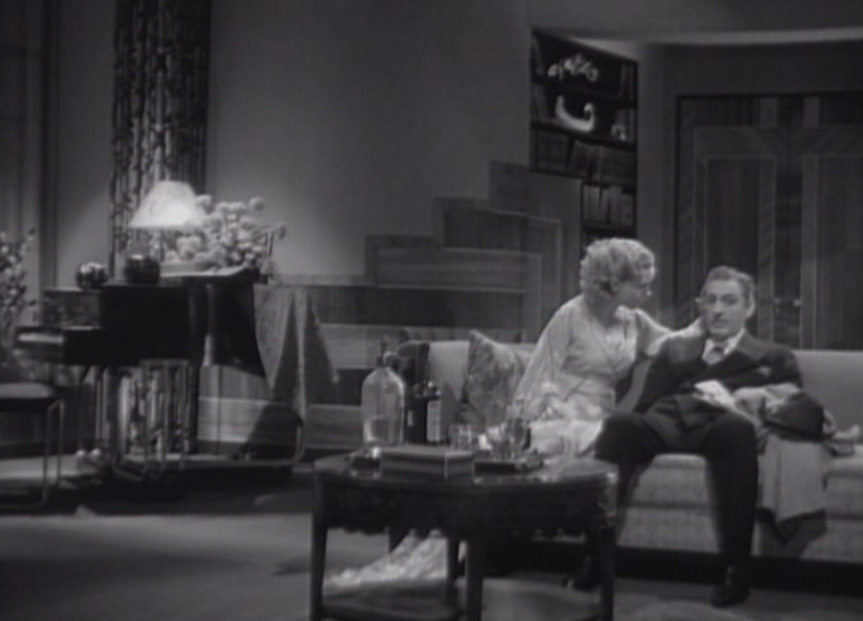
Eventually in the third and final courtroom scene Cardigan is forced to make a decisive decision and actually determine his own path. No longer able to straddle the thin line between right and wrong, virtue and pragmatic immorality, he chooses integrity and is rewarded with a return to respect and love.
This film contains a number of scenes and dialogue of a decidedly pre-Code nature. Here are just a few:
~After an intentionally direct kiss at his apartment following his defense of June, Cardigan needs to leave to collect his $5,000 from Powers. Her last words as he departs with his coat: “What do you want for breakfast?” Barrymore’s long, lingering and suggestive look tells us not only that he understands her meaning but exactly what he’d like.
~The murder weapon in the Nora Dean murder trial is a phallic-shaped weight that Cardigan taps rhythmically upon the marital bed.
~When Cardigan asks Lillian if she’s ever been in love she ascertains that he’s seeking to know some intimate information. She whispers in his ear and then pulls away asking “That’s what you wanted to know?” He replies, “That helps a lot” as he wraps his arms around her and pulls her into himself on the dance floor.
~June and Tom’s relationship is clearly one where they are living together without the benefit of a license. In fact June seems well aware that she doesn’t consider herself marriage material, not being a nice girl and anticipating “nicer girls” to come, even though Cardigan has let her know “I don’t like nice girls”.

~After marrying Lillian and regretting it, Cardigan states “June, it’s funny. I never realized what a beautiful thing marriage could be, until tonight. That’s one ceremony I’ve never been through. What a woman means to a man, and a man to a woman. And when I looked around, it wasn’t you…standing there… beside me”. The relationship between these two couldn’t be clearer. June stands her ground and sardonically responds, “I’m not one of your juries Tom”.
There is an economy of dialogue, story and editing that keeps this film moving at a brisk clip, with rarely a wasted movement, gesture or line. Yet it is the small touches that propel the story, set a quick pace, and make this film a fun watch. Barrymore’s entertaining flourishes, Twelvetrees’ pretty sensuality and a satisfying ending are details that seal the deal.

Recommended.
This post is a part of the “Order In the Court!” Blogathon June 10-13, 2016 hosted by Cinemaven’s Essays from the Couch and Second Sight Cinema

To read additional entries please visit: https://cinemavensessaysfromthecouch.wordpress.com/2016/06/10/order-in-the-court-now/
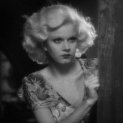 Notes and Extras
Notes and Extras
- Primary writer Gene Fowler wrote a biography of not only William J. Fallon but also subsequently another: Good Night, Sweet Prince: The Life and Times of John Barrymore. A long-time friend and drinking buddy, Fowler was also a member of the Bundy Drive Boys, a loosely-knit pre-Rat Pack Hollywood boys club that got its name from the location of their gatherings. It included such hard-living souls as Errol Flynn, W. C. Fields, Thomas Mitchell, Roland Young, John Carradine, Ben Hecht, a young Anthony Quinn and various other artists and writers. While their primary point of cohesion was alcohol they also shared many other ‘philosophies’ of living. For a more detailed account try “Hollywood’s Hellfire Club: The Misadventures of John Barrymore, W.C. Fields, Errol Flynn and “the Bundy Drive Boys” by Gregory William Mank with Charles Heard and Bill Nelson.
- Fowler also wrote the screenplay for What Price Hollywood?, whose main lead, played beautifully by Lowell Sherman (no stranger to alcohol himself), meets a far less redemptive fate than our hero here. What Price Hollywood? is considered the prototype, if not the first version of each of the subsequent A Star Is Born films. A favorite Fowler quote: “Hollywood is a place where you either ride in a Rolls Royce or are run over by one”, is reflected in the contrast between the main male leads in each of these two films.
- Fowler was at John Barrymore’s bedside just moments before he died, testimony to their enduring friendship. He, Lionel Barrymore and artist John Decker (whose home was host to the Bundy Drive Boys) were at John’s bedside for his final two days. After, Fowler kept vigil at night over the body with his son Will for safekeeping until arrangements could be made. Interestingly Decker is the name of Powers right hand man in State’s Attorney. On Bundy Drive apparently John Decker was a right hand man to many.
- Criminal defense attorney Fallon’s most famous client, Arnold Rothstein was known for fixing the 1919 World Series among other criminal and gambling related crimes. His partner and passionate defender (read frequent fall-guy) Nicky Arnstein was later immortalized in Funny Girl, the film depicting the life of Fanny Brice, an actress and wife who in the end found Nicky’s antics not so funny.
- Damned in Paradise: The Life of John Barrymore by John Kobler gives this movie a scant two sentence paragraph mention. There is actually little in print available regarding the filming of this one, probably in part due to the fact that, according to IMBd, it took a mere two weeks to shoot. Yet despite this it netted Barrymore a sum equivalent to over $1.7 Million, a figure that attests to the star’s one-time power in Hollywood. The book does mention that a line in the film is directly attributable to Maurice Barrymore, a star of the theater himself and John’s father. When shown a painting of a winter landscape by it’s artist and the speakeasy’s owner, Cardigan quips, “Winter isn’t as bad as it’s painted”. When I read these types of things I always wonder just how much of what we see on screen is attributable to John himself, building off a good (or sometimes weak) screenplay.
- Jill Esmond, in the role of Lillian Ulrich, was at the time of filming, Mrs. Laurence Olivier. As many of you know, this was not going to be the last marriage for Mr. Olivier as he would soon leave Esmond for Vivien Leigh.
- I perked up when I noted the name Ulrich, especially when I saw it in bold in a newspaper headline. There was a prominent society family at the time in Grosse Pointe, (a suburb just barely outside of Detroit) by the name of Ulrich. I only know this because I happen to be related to them. So I checked the writers. Sure enough writer Rowland Brown studied at the University of Detroit and the Detroit School of Fine Arts. Funny thing, a pretty brunette granddaughter of the Ulrichs did eventually marry a grandson of James J. Couzens, a former Mayor of Detroit and Senator, connecting herself to a political family. His son was also Mayor after him. A funny case of the movies having a strangely predictive tendency. Or just a crazy coincidence. And while the newspaper (and IMBd) clearly says Ulrich, the credits change the spelling to Ulric.
- Keep your eyes open for a brief appearance by Nat Pendleton playing a boxer who acompanies Cardigan and Lillian to a speakeasy after a fight. It just so happens that this club features a lively Theresa Harris singing her jazzy little heart out in a way too brief number. Both are uncredited.
- Watch the set design too in this one. There are large beautiful rooms, such as Tom Cardigan’s apartment and later he and June’s more upscale digs, that are lovely to look at. Just as lovely are the gorgeous gowns worn by Twelvetrees and the dresses and furs on Esmond. Art Direction is by Caroll Clark, costume design is unfortunately uncredited.
State’s Attorney is available from Amazon, Amazon Prime or occasionally for free viewing on TCM


































 Notes and Extras
Notes and Extras



